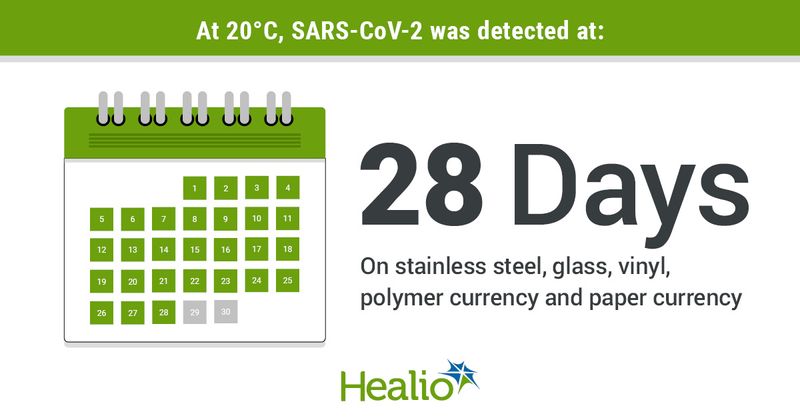SARS-CoV-2 found to live on surfaces longer than previously thought
Click Here to Manage Email Alerts
SARS-CoV-2 can remain infectious on surfaces significantly longer than what was previously considered possible, according to a study published in Virology Journal.
“At 20 degrees Celsius, which is about room temperature, we found that the virus was extremely robust, surviving for 28 days on smooth surfaces such as glass found on mobile phone screens and plastic banknotes,” Debbie Eagles, PhD, deputy director of the Australian Centre for Disease Preparedness, said in a press release. “For context, similar experiments for influenza A have found that it survived on surfaces for 17 days, which highlights just how resilient SARS-CoV-2 is.”

Previous research suggested that SARS-CoV-2 remained detectable on surfaces for up to 3 days.
Eagles and colleagues suspended SARS-Cov-2 in an ASTM E2197 matrix on several common surfaces, including polymer and paper currency, brushed stainless steel, glass, vinyl and cotton cloth. They used samples of SARS-CoV-2 with a concentration that mimicked body fluid composition.
Samples were tested at 50% relative humidity in three different temperatures: 20°C, 30°C and 40°C.
Eagles and colleagues found that at 20°C, SARS-CoV-2 was still detectable at 28 days on glass, polymer currency, stainless steel, vinyl and paper currency.
On cotton cloth, no infectious virus was identified past day 14.
They determined that at 30°C, infected virus was found for 7 days on stainless steel, polymer currency and glass, and for 3 days on vinyl and cotton cloth. Infectious virus was identified on paper currency for 21 days, but researchers noted that these were less than 1 log of virus recovered at day 14 and at day 21.
Virus recovery was significantly reduced at 40°C compared with lower temperatures. For instance, they found that infectious virus was not identified past 24 hours on cotton cloth or past 48 hours for all other surfaces.
“Our results show that SARS-CoV-2 can remain infectious on surfaces for long periods of time, reinforcing the need for good practices such as regular handwashing and cleaning surfaces,” Eagles said.
References:
Riddell S, et al. Virol J. 2020;doi: 10.1186/s12985-020-01418-7.

